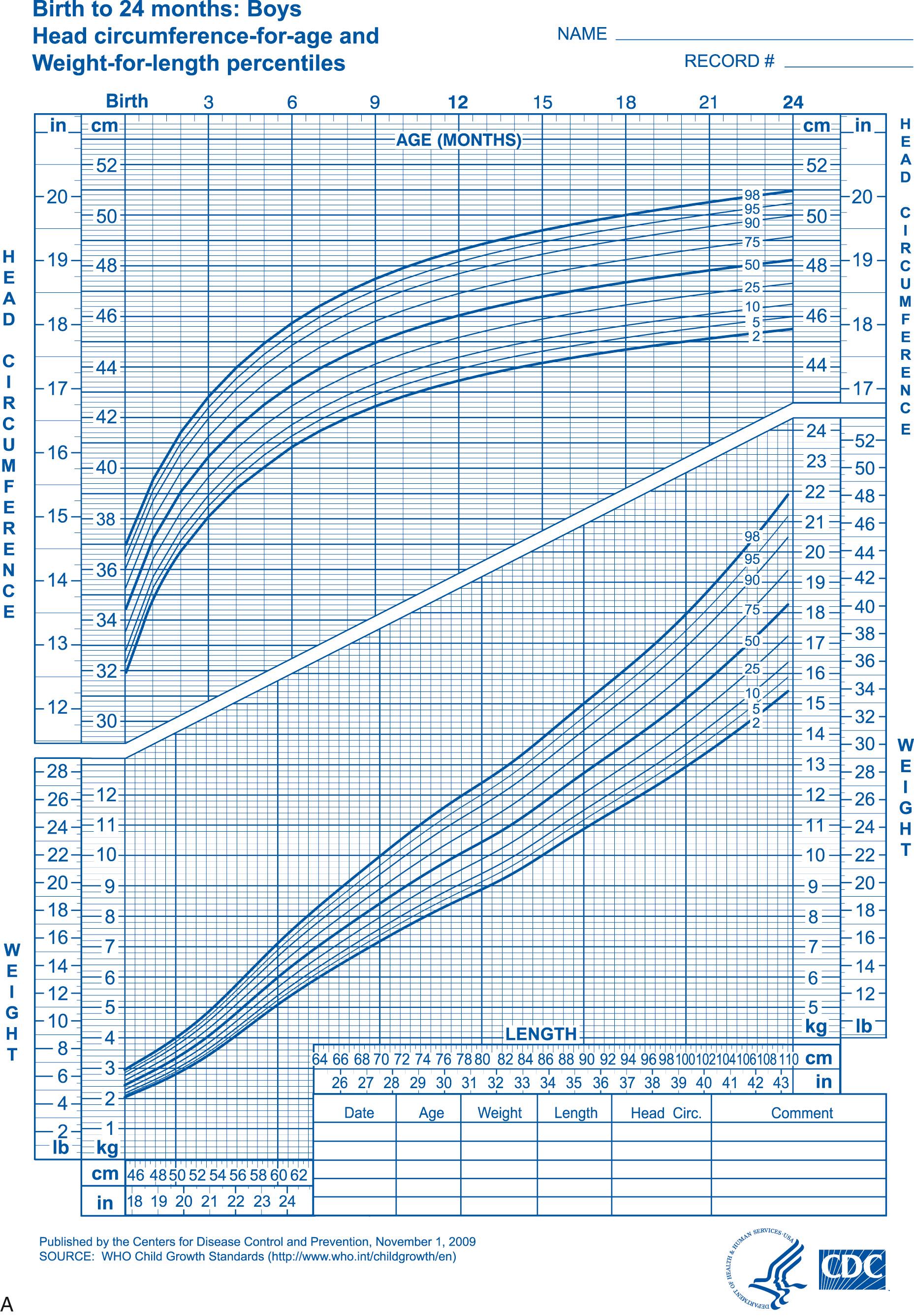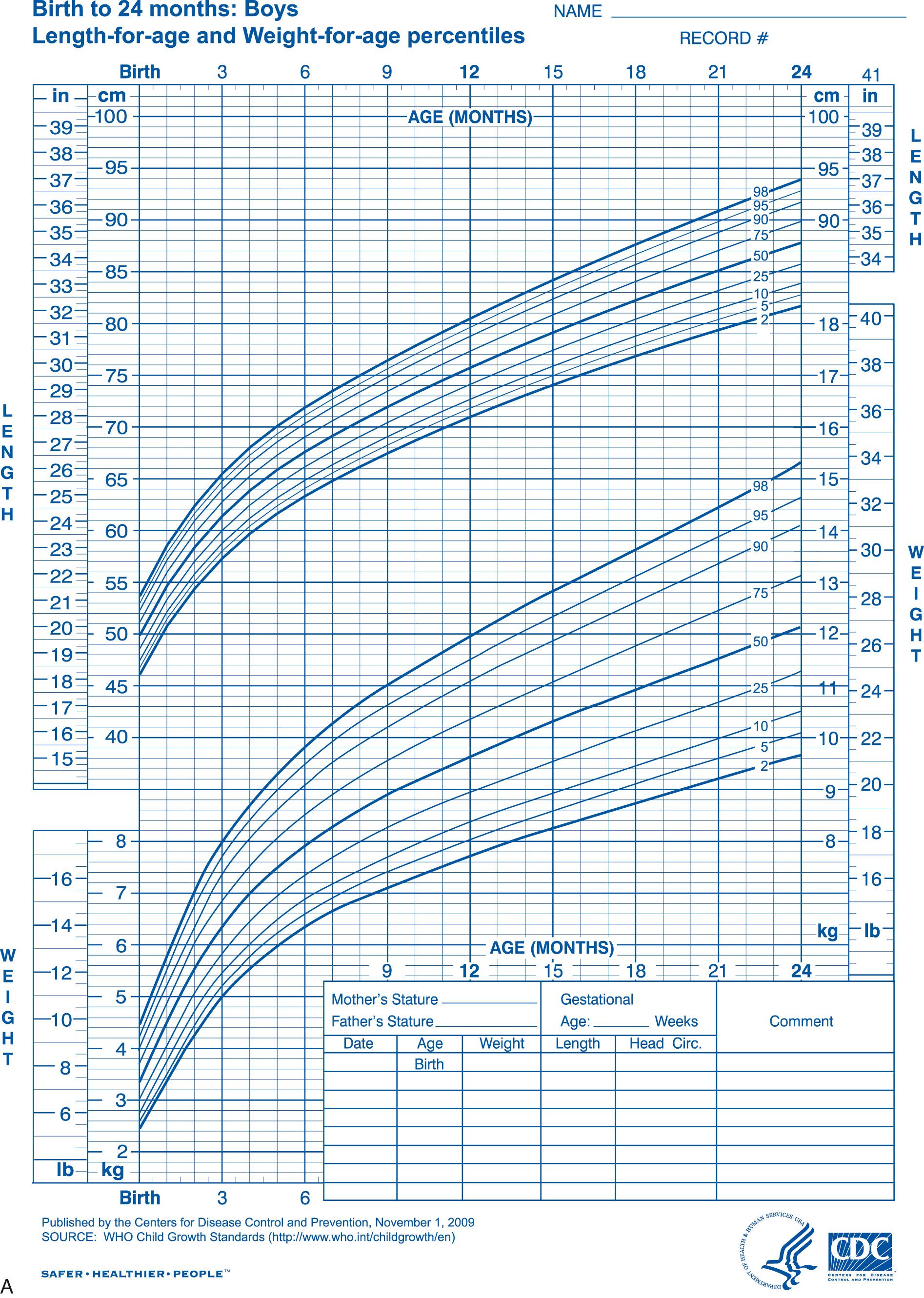Physical Address
304 North Cardinal St.
Dorchester Center, MA 02124
The 2nd year of life is a time of rapid growth of development, particularly in the realms of social-emotional and cognitive skills as well as motor development. The toddler's newly found ability to walk allows separation and independence; however, the toddler continues to need secure attachment to the parents. At approximately 18 mo of age, the emergence of symbolic thought and language causes a reorganization of behavior, with implications across many developmental domains.
While overall rate of growth continues to decline, the toddler continues to experience considerable brain growth and myelination in the 2nd yr of life, resulting in an increase in head circumference of 2 cm over the year ( Figs. 23.1 and 23.2 ). Toddlers have relatively short legs and long torsos, with exaggerated lumbar lordosis and protruding abdomens.


Most children begin to walk independently at about 12-15 mo of age. Early walking is not associated with advanced development in other domains. Infants initially toddle with a wide-based gait, with the knees bent and the arms flexed at the elbow; the entire torso rotates with each stride; the toes may point in or out, and the feet strike the floor flat. The appearance is that of genu varum ( bowleg ). Subsequent refinement leads to greater steadiness and energy efficiency. After several months of practice, the center of gravity shifts back and the torso stabilizes, while the knees extend and the arms swing at the sides for balance. The feet are held in better alignment, and the child is able to stop, pivot, and stoop without toppling over (see Chapters 692 and 693 ).
Exploration of the environment increases in parallel with improved dexterity (reaching, grasping, releasing) and mobility. Learning follows the precepts of Piaget's sensorimotor stage (see Chapter 18 ). Toddlers manipulate objects in novel ways to create interesting effects, such as stacking blocks or filling and dumping buckets. Playthings are also more likely to be used for their intended purposes (combs for hair, cups for drinking). Imitation of parents and older siblings or other children is an important mode of learning. Make-believe play ( symbolic play ) centers on the child's own body, such as pretending to drink from an empty cup ( Table 23.1 ; see also Table 22.1 ).
| 15 MO | |
| Motor: | Walks alone; crawls up stairs |
| Adaptive: | Makes tower of 3 cubes; makes a line with crayon; inserts raisin in bottle |
| Language: | Jargon; follows simple commands; may name a familiar object (e.g., ball); responds to his/her name |
| Social: | Indicates some desires or needs by pointing; hugs parents |
| 18 MO | |
| Motor: | Runs stiffly; sits on small chair; walks up stairs with 1 hand held; explores drawers and wastebaskets |
| Adaptive: | Makes tower of 4 cubes; imitates scribbling; imitates vertical stroke; dumps raisin from bottle |
| Language: | 10 words (average); names pictures; identifies 1 or more parts of body |
| Social: | Feeds self; seeks help when in trouble; may complain when wet or soiled; kisses parent with pucker |
| 24 MO | |
| Motor: | Runs well, walks up and down stairs, 1 step at a time; opens doors; climbs on furniture; jumps |
| Adaptive: | Makes tower of 7 cubes (6 at 21 mo); scribbles in circular pattern; imitates horizontal stroke; folds paper once imitatively |
| Language: | Puts 3 words together (subject, verb, object) |
| Social: | Handles spoon well; often tells about immediate experiences; helps to undress; listens to stories when shown pictures |
| 30 MO | |
| Motor: | Goes up stairs alternating feet |
| Adaptive: | Makes tower of 9 cubes; makes vertical and horizontal strokes, but generally will not join them to make cross; imitates circular stroke, forming closed figure |
| Language: | Refers to self by pronoun “I”; knows full name |
| Social: | Helps put things away; pretends in play |
| 36 MO | |
| Motor: | Rides tricycle; stands momentarily on 1 foot |
| Adaptive: | Makes tower of 10 cubes; imitates construction of “bridge” of 3 cubes; copies circle; imitates cross |
| Language: | Knows age and sex; counts 3 objects correctly; repeats 3 numbers or a sentence of 6 syllables; most of speech intelligible to strangers |
| Social: | Plays simple games (in “parallel” with other children); helps in dressing (unbuttons clothing and puts on shoes); washes hands |
| 48 MO | |
| Motor: | Hops on 1 foot; throws ball overhand; uses scissors to cut out pictures; climbs well |
| Adaptive: | Copies bridge from model; imitates construction of “gate” of 5 cubes; copies cross and square; draws man with 2-4 parts besides head; identifies longer of 2 lines |
| Language: | Counts 4 pennies accurately; tells story |
| Social: | Plays with several children, with beginning of social interaction and role-playing; goes to toilet alone |
| 60 MO | |
| Motor: | Skips |
| Adaptive: | Draws triangle from copy; names heavier of 2 weights |
| Language: | Names 4 colors; repeats sentence of 10 syllables; counts 10 pennies correctly |
| Social: | Dresses and undresses; asks questions about meaning of words; engages in domestic role-playing |
* Data derived from those of Gesell (as revised by Knobloch), Shirley, Provence, Wolf, Bailey, and others. After 6 yr, the Wechsler Intelligence Scales for Children (WISC-IV) and other scales offer the most precise estimates of cognitive development. To have their greatest value, they should be administered only by an experienced and qualified person.
Infants who are approaching the developmental milestone of taking their 1st steps may be irritable. Once they start walking, their predominant mood changes markedly. Toddlers are often elated with their new ability and with the power to control the distance between themselves and their parents. Exploring toddlers orbit around their parents, moving away and then returning for a reassuring touch before moving away again. A child with secure attachment will use the parent as a secure base from which to explore independently. Proud of her or his accomplishments, the child illustrates Erikson's stage of autonomy and separation (see Chapter 18 ). The toddler who is overly controlled and discouraged from active exploration will feel doubt, shame, anger, and insecurity. All children will experience tantrums, reflecting their inability to delay gratification, suppress or displace anger, or verbally communicate their emotional states. The quality of the parent–child relationship may moderate negative behavioral effects of childcare arrangements when parents work.
Become a Clinical Tree membership for Full access and enjoy Unlimited articles
If you are a member. Log in here